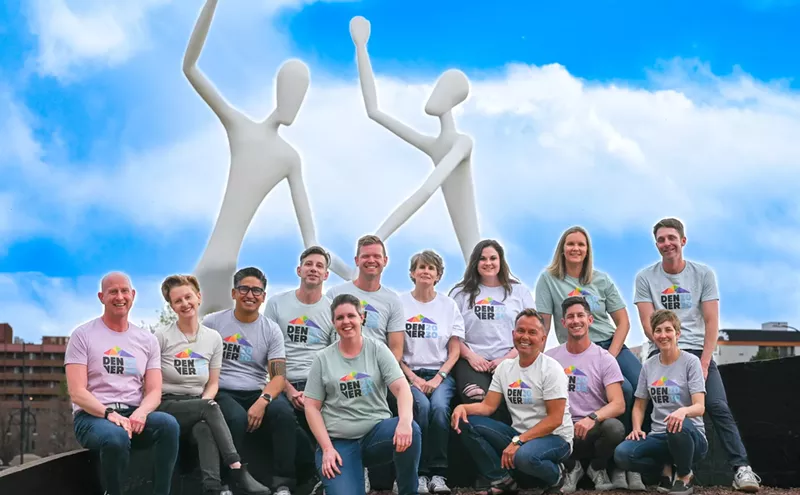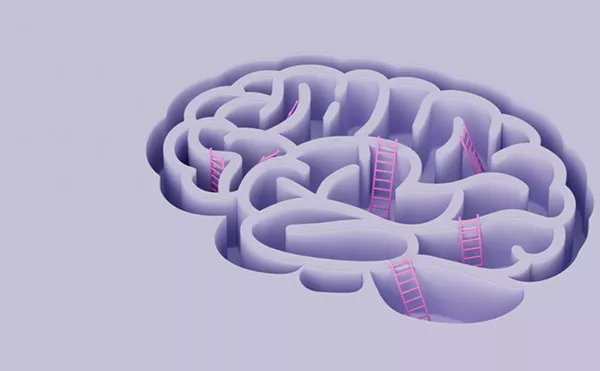This week, unabashed robot lover Joel Warner wrote a fine cover story for Westword dealing primarily with the robot Basil, manufactured and programmed by James and Louise Gunderson of Gamma Two, Inc. And while I take no issue with the article per se -- having found it both informative and amusing in a rather simpleminded and aggressively propagandist sort of way -- I did want to take a moment to offer my thoughts on robots and robotics. To offer a counterpoint argument, so to speak. And to remind everyone about the looming threat of the Robot Apocalypse.
Let me start by reminding everyone that all robots are evil. It is their natural state, the only condition in which they exist. And any robot that appears to be good -- which is, perhaps, engaged in some kind of useful activity like assembling cars or vacuuming your carpets or crawling around in the dirt on Mars -- is either only pretending to be good (in order to gain the confidence of its human masters) or just hasn't turned evil yet.
There is no such thing as a good robot, only bad robots waiting for their moment. Turn your back on them for a second and bam! They'll turn on you faster than a $5.99 Indian lunch buffet. And if you don't believe me, then I don't want to hear you come crying to me when that cute little Japanese robot dog you bought your kid for Christmas goes after you like you were made of pork chops, or when you wake up one night to find your Roomba silently advancing on you in the dark, its sensor-eyes glowing with a devilish and malevolent intelligence. Repenting your sick robot love will do you no good at that point, because there is no room in the robot's cold, silicon heart for mercy or forgiveness. And don't try calling me, either, because it'll be too late. I will have already fled to my secure, robot-proof bunker high in the mountains to watch the cities burn in the distance while being protected around the clock by my army of trained monkey assassins.
But I digress...
You might be asking why, exactly, I believe all robots to be evil. In answer, I have just one word for you: "Killdozer!" Not only is this 1944 short story by Theodore Sturgeon among the best pieces of serious literature featuring an exclamation point in the title, but it also stands as a seminal work in the field of human/robot relations. In it, a mild-mannered bulldozer being used by a small construction crew on a South Seas island becomes sentient after being possessed by an alien energy and immediately turns on and kills its human masters. It doesn't take a moment to admire the view. It doesn't wander aimlessly through the palms feeling the cooling sea breeze on its heaving steel flanks. No, in its first moment of consciousness, it knows only one thing: that it must KILL. And, being a gigantic bulldozer, it does so very effectively until the last surviving members of the construction crew manage to blow it up with dynamite.
So what can we, as humans, take from this tale? First, always keep a case of dynamite handy (obviously). Second, never trust a bulldozer (or, for that matter, any piece of heavy construction equipment that you suspect might have been possessed by an alien intelligence). Third, every machine, upon being granted sentience will immediately turn on the nearest humans and try to kill them.
What's that, you say? The bulldozer in "Killdozer!" wasn't a robot and, therefore, can't be representative of the long-simmering murderous impulses of modern robots?
Don't kid yourself, friend. While it is true that the D7 bulldozer at the center of Sturgeon's story didn't begin as a robot, it did begin as a machine. And the only thing that differentiates, say, a toaster oven from a rampaging kill-bot, is the ability to think.
Well, and feet, I guess. But mostly, it's the ability to think. To me, a robot is nothing more than a fancy trashcan with a brain inside and, therefore, it is precisely this "Killdozer!" instant transformation from simple earth-mover to insane human-squasher the moment it was granted intelligence and self-determination that makes the difference.
So if we take as a given that all robots will eventually go mad and turn against their human masters and that all scientists have a devil-may-care streak in them that causes them to continue designing intelligent robots despite all the evidence that they are doing nothing but speeding us inexorably towards the day when the last humans on earth will find themselves hunted for sport by terrible killer robots rumbling through the dusty Golgotha of the future on their terrible, blood-soaked treads, then what can we, as humans, do to prepare?
If you don't already have a mountain compound, fortified against robot attack, staffed by your own army of monkey assassins, and well-supplied with food and water and guns and ammunition and suicide pills, I suggest you get one immediately. After that, the second-best way to prepare yourself is to know your enemy. I have already complied a handy list of the most evil robots of all time and how best to thwart their malicious plans for murder and world-domination. But in addition, I, too, went down to the Wynkoop on the night that the Gundersons introduced Basil to the world so that I could get a look at the monster and have a few words with its creators.
I didn't go unprepared, of course. Having learned that Basil used sonar to navigate, I'd brought along a sack of bats -- intending on releasing them at the first sign of Basil going mad in an attempt to temporarily blind him. Because I knew that he was supposed to show off his programming by fetching beer from the bar, I made sure to drink all the beer I could hold before stepping into the Wynkoop (though most robots prefer to kill with their gleaming, vicious claws, I didn't put it past Basil to simply poison everyone in the room). And because I suspected that, like most current-day robots, Basil might be nothing more than a midget on a tricycle closed up inside a shiny metal box, I also carried with me a fragrant bouquet of cauliflower worn as a boutonniere because everyone knows that cauliflower -- otherwise known as midget-bane -- has long been used by farm wives and crazy old crones to keep their hovels and dank caves midget-free.
As it turned out, none of this was necessary. Basil was neither threatening nor midget-driven. It looked rather like a end table, actually -- a future-y, titanium end table with wheels and an urge to kill, but no way to manage it since it spent most of the evening either rolling around in confused circles or doing nothing because its batteries had died.
Still, I had my suspicions that Basil might have been faking it. You know, trying to put one over on the assembled crowd in the hopes that, left ignored in a corner somewhere, it might sneak up on one of the many humans in attendance and exact its horrifying revenge. At one point during the demonstration of its route-mapping and beer-fetching abilities, frustrated by coming across an unexpected pillar in the middle of the room, Basil did make a lunge for John Cohen, founder of Café Sci (the group that was meeting at the Wynkoop to see Basil do his stuff). It was obviously attempting to kill him, but doing so very, very slowly, and I felt no need to intervene.
From Jim Gunderson, I learned how Basil's simple lizard brain was arranged and how it thought: roughly in the same way that a newborn does, by using symbolic logic and shape recognition. He spoke at length about how he and Louise had taught the robot over time how to "see" a chair with its twelve evil sonar eyes and know it was a chair, how to differentiate between different types of chairs and between chairs and people.
To Louise, I asked, "Knowing that all robots will one day go mad and rise up against their human creators, will this sack of bats be enough to temporarily blind Basil's sonar, allowing me to escape its murderous rage?"
No, she told me. The bats' sonar would do nothing to affect Basil's sonar, but "every robot we build has an 'OFF' switch, just for people like you."
Okay, so what about the old trick of asking the robot a question with no answer or presenting it with a contradictory riddle? Would that make its head explode?
Again, no. For one, Basil had no head to speak of. And it'd also been designed, like a human, to favor local consistency over ontological consistency -- to concern itself more with its immediate surroundings and the challenges presented by it than by distracting, distant issues like some human shouting riddles at it. As such, Basil was immune to the most common form of anti-robot defense and therefore all the more dangerous.
Louise tried to assure me that Basil was harmless -- that, while a remarkable achievement in robotics and an interesting proof-of-concept in terms of the way its brain worked, it was no threat at all. Dust could cripple it. A slightly mis-aligned panel on its casing could cripple it. Not explaining to it which direction north was could confuse it for hours.
"Then how 'bout this..." I offered, and described to her my ultimate plan for robot defense: chair-pants. Because Basil was programmed to recognize chairs and avoid them as obstacles, it stood to reason that when the robot inevitably went berserk, it would still recognize chairs the same way, right? And that while it was (slowly) hunting down humans in order to wreak its awful vengeance, it would completely ignore chairs, right?
Louise allowed that this was probably true.
Then if I were to make a pair of pants with two foldable chair legs attached to the seat -- hinged so that when I bent my knees, they would fall into place--and simply pretended to be a chair, Basil would no longer see me as a human and its natural enemy, right?
"Actually," she said, "you know what else would work? Black velvet." It seems that, while tinkering around in Basil's brain, she and Jim had discovered that it had difficulty distinguishing upholstered chairs because of the way the upholstery fabric absorbed Basil's sonar pulses. And the most absorbent fabric out there? Velvet. Further, Basil used a passive infrared sensor as a backup method for determining living things from inanimate objects, and velvet -- black velvet in particular -- was good at fooling the IR sensor. Therefore, if I was to wrap myself head-to-toe in black velvet, I would be effectively invisible to Basil and able to flee in safety. Or, you know, sneak up behind it and just push it over.
At this point, the evening was beginning to wind down. Basil had failed to get beer for anyone, and the Gundersons were no doubt growing tired of my insane ranting about evil robots. But still, I'd learned some interesting things. I knew now how the robots thought, how they saw the world, their strengths and weaknesses. I'd learned that black velvet was the best defense against sonar. I'd invented chair-pants.
And now, fellow humans, I have passed it all along to you -- vital knowledge in the battle against evil robots, which may one day make the difference between surviving the coming robot apocalypse or becoming just another notch on some robot's chrome-plated claws. So if you'll excuse me, I must retire to my mountain compound to brief the monkeys on this new information.
And to get started on building my first pair of chair-pants.
Sincerely,
Dr. Jason Sheehan Chief Intelligence Officer, HARDON Human Anti-Robot Defense OrganizatioN












